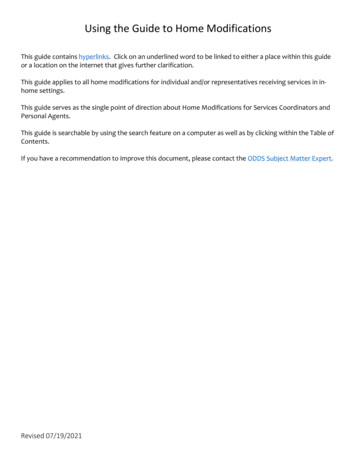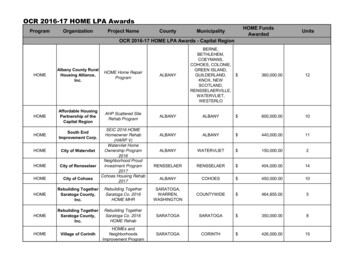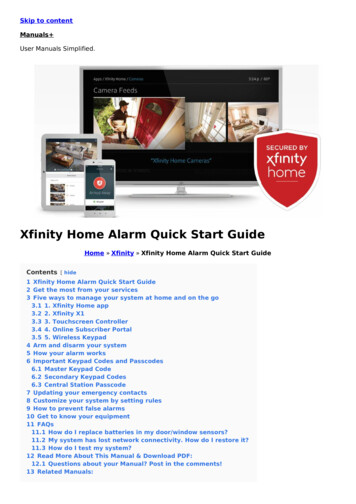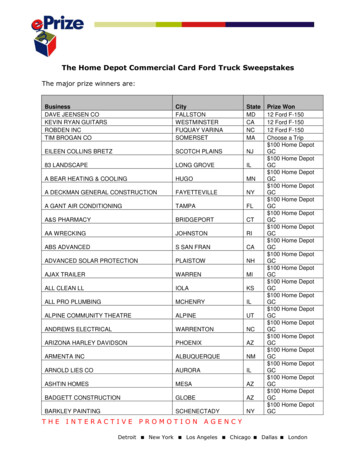
Transcription
Using the Guide to Home ModificationsThis guide contains hyperlinks. Click on an underlined word to be linked to either a place within this guideor a location on the internet that gives further clarification.This guide applies to all home modifications for individual and/or representatives receiving services in inhome settings.This guide serves as the single point of direction about Home Modifications for Services Coordinators andPersonal Agents.This guide is searchable by using the search feature on a computer as well as by clicking within the Table ofContents.If you have a recommendation to improve this document, please contact the ODDS Subject Matter Expert.Revised 07/19/2021
The Guide toHome ModificationsRevised 07/19/2021WORKER GUIDE
Home ModificationsChapter 1 Rules and References . 1Chapter 2 Definitions . 2Chapter 3 What are Home Modifications .3Environmental Modifications .3Environmental Modification Exclusions . 4Environmental Safety Modifications .5Environmental Safety Modification Exclusions. 6Chapter 4 Eligibility . 2Environmental Modifications . 2Generators and Back-Up Systems .3Environmental Safety Modifications .3Additional Requirements: . 4Exclusions .5Chapter 5 Requesting a Scope of work . 6Process for Requesting a Scope of Work . 6Rental Properties. 10Easements . 10Repairs to Home Modifications . 11Chapter 6 Reading and Understanding the Developed Scope of Work . 12Asbestos . 12The Payment Process . 12Chapter 7 Plan of Care . 14Plan of Care for CDDPs and Brokerages . 14Plan of Care for CIIS. 15Chapter 8 Understanding the Contractor’s Role . 15Written Bids . 16Chapter 9 Subject Matter Expert . 17Appendix A: Process Map. 18Appendix B: Helping an individual or Family Understand Home Modifications . 19Appendix C: Reading a Scope of Work . 20Appendix D: When talking with the construction contractor . 21Appendix E: NOPA . 22Appendix F: Examples of Assessed ADLs, IADLs, Behavior and Medical Supports .24Appendix G: Home Owner/Landlord Consent to develop Scope of Work . 25Appendix G: Home Owner/Landlord Consent for Home Modification . 26Revised 07/19/2021
Home ModificationsRules and ReferencesChapter 1 Rules and References OAR 411-435 outlines Home Modifications including both Environmental Modifications andEnvironmental Safety Modifications.Action Request regarding Funding Review and Exceptions: APD-AR-18-053Code of Federal Regulations: 441.520(b)(2)Community First Choice K-plan1915(c) WaiversExpenditure GuidelinesThis worker guide replaces the following guides which were announced in APD-IM-16-036:Modifications Implementation Worker GuideEnvironmental Modification Policy Worker GuideEnvironmental Safety Modification Policy Worker GuideSupplemental Support Document formRevised 07/19/2021Page 1
Home ModificationsDefinitionsChapter 2 DefinitionsADL/IADL: Activities of Daily Living and Instrumental Activities of Living are identified in an individual’sneeds assessment. The OAR definitions can be found: ADL: 411-317-0000(6) IADL: 411-317- 0000(103).See Appendix F for examples of ADLs and IADLs.Bids: An offer to provide construction services at a certain price. The bid must conform to theapplicable requirements set forth in the scope of work such as content, form and timeliness.Cost Effective: The most efficient and economical service, product, material and/or solution thatwill address the stated health, safety, or independence need of the individual.Home Modifications: This term refers to both Environmental Modifications and Environmental SafetyModifications. They physical adaptations to an individual’s or family home necessary to ensure the health,welfare and safety of the individual in the home or that enable the individual to function with greaterindependence in the home and lead to a substitution for or decrease in direct human assistance to theextent expenditures would otherwise be made for the human assistance.Funding Review and Exceptions Request: A request for an item or identified need when the item exceedswhat can be authorized by the services coordinator or personal agent using form 0514dd. The process forsubmitting a request and review for authorization can be found in the Expenditure Guidelines listed in the“Resources” section. Additional information about the state review process can be found in APD-AR-18053Good Repair: In general, the term ‘good repair’ means that the property is in as satisfactory acondition as another person would expect of the same property. The home must be structurallysound. It is the homeowner’s responsibility to bring the home up to code prior to the construction ofthe scope of work as it pertains to the scope of work. The home must be well taken care ofnotwithstanding ordinary wear and tear which isn’t preventable through diligent repairs andmaintenance. Keeping a home in good repair is the homeowner’s responsibility. Bringing a home to astate of good repair prior to the inclusion of a home modification is the homeowner’s responsibility.Invoice: A commercial document issued by a Contractor relating to the transaction indicating theproducts, work completed and agreed upon price for services provided.Primary Residence: Primary residence is the legal residence of the individual. A person can only have oneprimary residence at any given time, though they may share the residence with other people or spend timein other residences.Scope of Work: The written statement of all proposed work requirements for any Home Modification.The scope of work may include dimensions, measurements, materials, labor, any pertinent buildingpermits and outcomes necessary for a contractor to submit a proposal to complete such work. The scopeof work is specific to the identified tasks and requirements necessary to address the assessed needsdocumented in the individual’s Support Plan (ISP). The scope of work must relate to the assessedADL/IADL needs or health-related tasks of the individual. Scopes of work may only be completed by anRevised 07/19/2021Page 2
Home ModificationsWhat are Home ModificationsODDS Environmental Modifications Field Consultant.Chapter 3 What are Home ModificationsThe term “Home Modifications” refers to both Environmental Modifications and EnvironmentalSafety Modifications.Environmental ModificationsEnvironmental Modifications are services available through the K-Plan. They are physicaladaptations made to the interior of an individual’s primary residence, with the exception oframps, intended to: Meet an assessed need for assistance with ADL/IADL or health related tasks as identified in thefunctional needs assessment. See Appendix F for examples. Ensure the health, welfare and safety of the individual in the home; and/or Enable the individual to function with greater independence in the home; and/or Replace or decrease direct human assistance.Environmental Modifications including but not limited to the installation of products / materials andmechanical, electrical, plumbing and/or structural alterations must be completed by a licensed andqualified contractor or trade professional.Examples of environmental modifications include but are not limited to: Installation of shatter-proof windows and/or safety film; Specialized, hardened, waterproof, or padded doors, walls and/or flooring; Installation of ramps, grab-bars; Adaptation of kitchen cabinets and sinks; Widening of doorways; Interior handrails or handrails accompanying and exterior ramp; Modification of bathroom facilities; A room air conditioner (a single window unit) for an individual whose temperature sensitivityissues create behaviors or medical conditions that put the individual at risk; Installation of anti-slip flooring and/or walkways; Overhead track systems to assist with lifting or transferring; Specialized electrical and/or plumbing systems necessary to operate medical equipmentand supplies required for the welfare of the individual; Adaptations to control lights, heat, and stove electric door openers; Tub cut (converting an existing bathtub into a walk-in tub/shower or roll-in tub/showerrather than remodeling the entire bathroom); Construction of a ramp in which to access homeRevised 07/19/2021Page 3
Home ModificationsWhat are Home ModificationsEnvironmental Modification Exclusions Home maintenance and repair are the responsibility of the homeowner and cannot be funded utilizingDepartment funds. This includes the maintenance and repair of any previously funded homemodification. Once the Environmental Modification has been constructed, maintenance and repair arethe homeowners responsibility. OAR 411-435-0050 (7)(c) states that environmental modifications exclude:o Adaptations or improvements to the home that are for general utility;o Adaptations that add to the total square footage of the home.o General repair or maintenance and upkeep required for the home.o Garages, out-buildings and/or similar structures, whether or not they are attached to thedwelling, are not part of the square footage of the home and cannot be modified.o Adaptations outside of the home, such as fences and walkways are identified asenvironmental safety modifications. NOTE: Ramps do not add square footage to the interior of a home and are therefore not excluded.Ramps that attach to the home for the purpose of entry or exit are not excluded. Examples of excluded modifications include but are not limited to:o Home maintenance and repair are the responsibility of the homeowner and cannot be fundedutilizing Department funds. This includes the maintenance and repair of any previously fundedhome modification. Once the Environmental Safety Modification has been constructed,maintenance and repair are the homeowners responsibility.o Carpeting;o Central air conditioning;o The main garage door that allows the vehicle to enter/exit the garage;o Provision or replacement of household appliances that are considered customarily theresponsibility of any homeowner to include but not be limited to: Refrigerators Microwaves Dishwashers Clothes washer & dryer Furnishings for walls, windows and doors to include but not be limited to drapes,shades and decorative elements.o Upgrades in materials that are not directly related to the assessed health and safety needsof the individual. Environmental modification example: An individual or family member requestsgranite or tile in a bathroom modification when a fiberglass surround willaddress the shower safety needs at a lower cost.Revised 07/19/2021Page 4
Home ModificationsWhat are Home Modificationso Repairs or updates necessary in order to complete the environmental modification. Examples: A bathroom needs adaptation to install a new commode for anindividual. In order to replace the commode, the flooring must bereplaced due to dry rot or decay. The new commode could be approved.The sub-flooring, etc., could not be approved. The property owner mustfirst fix the flooring before the environmental modification could beapproved. In order to complete a bathroom remodel, pipes in the bathroom need to bereplaced. In the course of the repairs the local inspector then determines thatall pipes throughout the house must be brought up to code. The cost to bringother parts of the home up to code cannot be paid by ODDS. The homeownermust fix or replace the pipes before the environmental modification couldcontinue. In order to install a ramp, repairs to the porch or deck must be made tosupport the ramp. The ramp could be approved; the repairs to the existingporch or deck could not be approved. The homeowner would be responsiblefor the repairs before the environmental modification could continue.Environmental Safety ModificationsEnvironmental Safety Modifications are available through the ODDS 1915C waivers. They arephysical adaptations made to the exterior of an individual’s primary residence, with the exceptionof ramps (which are considered Environmental Modifications), intended to: Ensure the health, welfare and safety of the individual around the home; and/or Enable the individual to function with greater independence around the home; and/or Replace or decrease direct human assistance.Exterior ramps are funded through the Environmental Modifications procedure codes.Environmental Safety Modifications including but not limited to the installation of products /materials and mechanical, electrical and/or structural alterations must be completed by a licensedand qualified contractor or trade professional.Revised 07/19/2021Page 5
Home ModificationsWhat are Home ModificationsExamples of Environmental Safety Modifications include Pathways Fences For individuals with a history of elopement or bolting, a backyard fence may beauthorized with a maximum perimeter of 200-linear feet. An exceptions request can be submitted to ODDS to exceed the linear footmaximum for fencing. The case management entity should always considerhow the home modification will meet the individual’s assessed need. For individuals with a history of elopement or bolting, a backyard fence maybe authorized with a 4’ gateEnvironmental Safety Modification Exclusions Examples of excluded modifications include but are not limited to:o Roof repair;o The main garage door that allows the vehicle to enter/exit the garage;o Upgrades in materials that are not directly related to the assessed health and safety needsof the individual. Example: An individual or family member requests a chain-link fence when a woodfence will address the safety needs at a lower cost.o Repairs or updates necessary in order to complete the environmental safety modification. Example: A back yard has a slope close to the property line. A retaining wall wouldbe needed to structurally support a fence in that location. ODDS will not authorizefunding for the retaining wall as this is not directly associated with the individual’sassessed need. The building of the retaining wall is considered to be a homeowner’sresponsibility. The scope of work could consider construction of the fence to bebuilt a safe distance away from the slope. Revised 07/19/2021Page 6
Home ModificationsEligibilityChapter 4 EligibilityEligibility for Home Modifications are limited to individuals who are: Community First Choice (K-plan) eligible AND; Enrolled in one of the following service elements:o DD49 Adult In-Home services - CDDPso DD51 Supported Living services (if the dwelling is not owned by the provider)o DD149 Adult In-Home services - Brokerageso DD151 Children In-Home serviceso DD145 Children's Intensive In-Home Services (CIIS) The assessed need for the Home Modification must be identified and documented in the ISP. The Home Modification must be the most cost-effective alternative to address the need(s) of theindividual. The Home Modification must not be able available by another resource.Environmental ModificationsIn addition to the eligibility requirements listed above, any Environmental Modification must eitherincrease independence or reduce need for human assistance and meet an individual’s assessed need forassistance with ADL/IADL and/or health-related tasks or meet a behavior support need. When submittinga Funding Review or Exception Request, it is imperative that the need for an Environmental Modificationis explained in terms of how the modification will increase the individual’s ability to be more independentand complete ADL/IADLs with a reduced need for another person’s support. It is also possible that themodification will reduce the risk of harm related to behavior or medical supports. This must be explainedon the Funding Review or Exception Request.For example: an individual uses a wheelchair for mobility and cannot reach the counters in thekitchen, requiring a caregiver to support them with meal preparation. An environmentalmodification to the kitchen lowering the cabinets would enable the individual to be moreindependent in meal preparation thereby decreasing the need for caregiver support during mealpreparation and enabling the individual to meet an assessed ADL/IADL need.See Appendix F for more examples of assessed ADLs, IADLs, Behavior and Medical Supports.Revised 07/19/2021Page 2
Home ModificationsEligibilityGenerators and Back-Up SystemsLifesaving equipment disbursed through a Durable Medical Equipment (DME) supplier/vendor will have abuilt-in and/or external system to keep the equipment running when the individual is out in the communityor in the event of a power outage (e.g., internal or external battery source). In addition, DMEPOS rulesrequire that DME suppliers ensure that an appropriate and acceptable contingency plan to addressemergency situations or mechanical failures if a ventilator is being used. This could mean that the DMEprovider furnishes a backup ventilator at no charge to the Department or the individual. The ServicesCoordinator or Personal Agent may assist the individual in working with their insurance provider to accessback-up systems for life saving equipment. The rule that applies to DME supplier’s responsibility is OAR410-122-0210(4)(b)(A). This rule does not imply that DME suppliers must provide generators. It means thatthey must have a plan in place to deal with any equipment failure/interruptions that may be lifethreatening.Environmental Safety ModificationsIn addition to the eligibility requirements for Home Modifications listed above, any EnvironmentalSafety Modifications must be intended to ensure the health, welfare, and safety of the individual.For example: an individual relies on a wheelchair for mobility and the space between thedriveway and ramp to the front door is not safely navigable independently by wheelchair,requiring a caregiver’s assistance. A paved pathway from the driveway to the ramp would allowthe individual to be able to navigate independently.Revised 07/19/2021Page 3
Home ModificationsEligibilityAdditional Requirements: The dwelling and property must be in good repair prior to the commencement of anymodification project. It is the responsibility of the homeowner to bring the property into astate of good repair. ODDS may require copies of permits outlining that the work has beencompleted to code. Examples of repair that ODDS does not fund include, but are not limited to:o Plumbing issues such as dripping faucets, running and/or clogged toilets, or theremoval of mold, mildew, leaking drains or “spongy” flooring.o Peeling paint and wall paper, torn carpeting, water damage to ceilings and floorsor damaged flooring.o Inadequate ventilation, evidenced by mold, termites or other pests, water damageor “spongy floors” The identified home or dwelling cannot be in foreclosure or be a subject of legal proceedingsregarding ownership. ODDS requires written permission from the homeowner (or landlord / rental propertymanagement company) approving the modification. This requirement is for all homemodifications even when the individual resides in their own or family home. Furtherrequirements regarding rental properties are addressed below.Revised 07/19/2021Page 4
Home ModificationsEligibilityExclusionsIndividuals living in a home that is licensed as a 24-hour residential program, licensed/certified foster carehome, supported living site owned or operated by the provider, residential treatment facility, residentialtreatment home, assisted living facility, or residential care facility are not eligible for K-Plan fundedenvironmental modifications or waiver funded environmental safety modifications. The provider of thehome in the above situations, are responsible for all modifications needed in those settings.Assistive Devices, Assistive Technology and the installation of Personal Emergency Response Systems arenot considered environmental modifications. A scope of work may suggest a shower chair, portable lift,weighted shower curtain, black-out shades, or another mechanism that does not become a part of thestructure of the home but will not be included as part of the modification. The Services Coordinator orPersonal agent may consider if these items can be funded as an Assistive Device or may request a FundingDecision or Exception Request outlining the request for the specific assistive device, assistive technologyor ERS. Refer to the Assistive Devices and Technology Worker Guide for additional details and information.The following items do not qualify as home modifications but may qualify as an Assistive Device:o Locks on doors or cabinetso Alarm systems that are not hard wiredo Protective coverings for entertainment systemso Gated windowso Window curtains or shower curtainsRevised 07/19/2021Page 5
Home ModificationsRequesting a Scope of workChapter 5 Requesting a Scope of workA scope of work must be completed for each identified Home Modification request or project. Thismeans that if an individual needs both an entryway ramp as well as a lift system within the bedroom tobathroom, there will be a scope of work for the ramp and a separate scope of work for the lift system.This allows the work to be bid by separate contractors if necessary. Scopes of work must be completedby an ODDS Environmental Modifications Field Consultant, approved by ODDS and signed by theindividual or family, prior to the acquisition of any bid to construct the modification. All contractorssubmitting bids must be given the same scope of work from which to submit a competitive bid. How doyou know if a Scope of Work is required? If a device attaches to the home or is intended to be weightbearing, a Scope of Work is required.Process for Requesting a Scope of WorkRequesting a Scope of Work1. Service Coordinators or Personal Agents may suggest modifications or respond to the individualsrequest for specific modifications. Service Coordinators or Personal Agents need to be able to seethe home and understand what is not working or needs to work better with the completion of themodification specific to the individual’s identified support need. Once the Services Coordinator orPersonal Agent sees the home and understands the need for the modification, they must submit aFunding Review and Exceptions Request to begin the process of requesting a scope of work. If an individual requests a specific modification and the Service Coordinator or PersonalAgent is unable to support the request when there is no identified support need, theService Coordinator or Personal Agent must issue a Notification of Planned Action.2. ODDS reviews the request to ensure that the requested Home Modification adheres to OAR 411435. If the situation is emergent, the ISP team should consider alternatives. Homemodifications are not intended for emergency situations.3. The request for the development of a Scope of Work must include homeowner permission(regardless of the ownership of the home.4. ODDS will notify the Case Management Entity if the request requires additional information priorto approval of the development of a scope of work or notify the Case Management Entity if aNOPA needs to be issued if the development of a scope of work cannot not authorized.5. Following the approval to have a scope of work completed, an Environmental Modifications FieldConsultant will be assigned, as they have capacity, to accept new referrals and as they areavailable in the geographic location where the individual resides. If necessary, the request for a Scope of Work may be prioritized based on need, geographiclocation, and order in which the request was received.6. The Environmental Modifications Field Consultant will contact the Services Coordinator orPersonal Agent and together they will arrange to visit the primary residence of the individualRevised 07/19/2021Page 6
Home ModificationsRequesting a Scope of workwhere the modification is proposed. This may be several months after the initial submission of the Funding Review andException Request was first submitted.7. The Environmental Modifications Field Consultant will complete the Scope of Work and return itto ODDS.8. ODDS will review the Scope of Work as it relates to the documented identified need. Uponapproval, ODDS will send the approved Scope of Work to the Services Coordinator or PersonalAgent.9. The Services Coordinator or Personal Agent must review the completed ODDS approved scope ofwork with the individual and/or representative within two weeks and:a.) If the scope of work meets the assessed need the individual and/or representative signsthe final page of the scope of work. The signed scope of work must be returned toODDS at ODDS.FundingReview@state.or.us within 2 weeks (date is identified on thedocument)ORb.) Documentation is included on the final page of the scope of work to indicate how theassessed need is not met with the scope of work as written. The unsigned scope ofwork with description of unmet need is returned to ODDS atODDS.FundingReview@state.or.us.i. ODDS will review the reason and documentation regarding why the scope of workdoes not meet the need of the individual.ii. If the scope of work can be adjusted to more accurately meet the assessed need,ODDS will work with the EMFC and then send a revised scope of work to theServices Coordinator or Personal Agent.iii. If it is determined that the assessed need cannot be met with the scope of work orthat the request is not the most cost-effective method of meeting the assessedneed then ODDS will issue a Notification of Planned Action to the individual and/orrepresentative.iv. An individual has the right to close a request by choosing not to accept the scope ofwork as written or choosing not to accept the materials or items identified to be themost cost effective and adequate to meet the identified or assessed need of theindividual the individual.10. The Service Coordinator or Personal Agent must return the signed scope of work to ODDS toODDS.FundingReview@state.or.us indicating that the individual and/or representative agreesthat the scope of work will meet the assessed need.Solicitation of bids for the modification:Revised 07/19/2021Page 7
Home ModificationsRequesting a Scope of work11. Following receipt of the signed scope of work, ODDS will notify the Services Coordinator orPersonal Agent that they may assist the ind
This includes the maintenance and repair of any previously funded home modification. Once the Environmental Modification has been constructed, maintenance and repair are the homeowners responsibility. OAR 411-435-0050 (7)(c) states that environmental modifications exclude: o Adaptations or improvements to the home that are for general utility;











